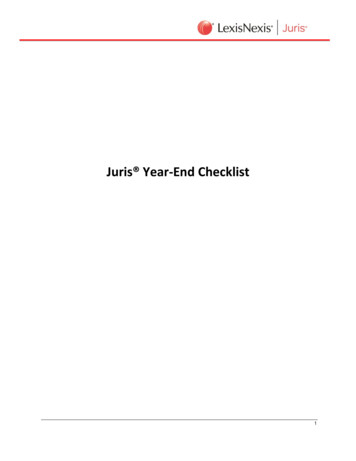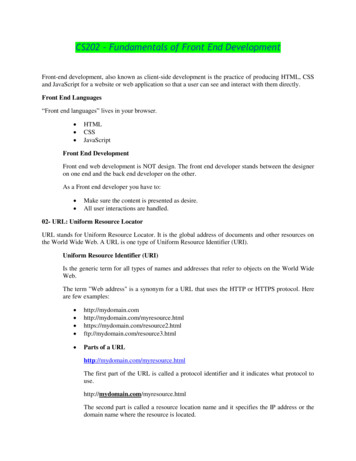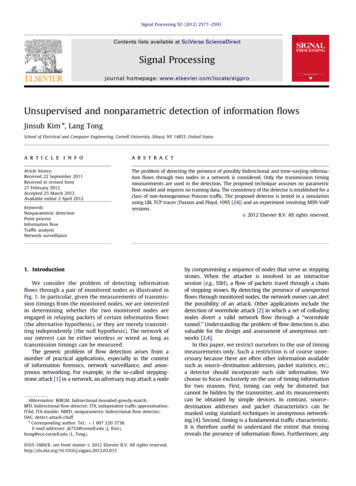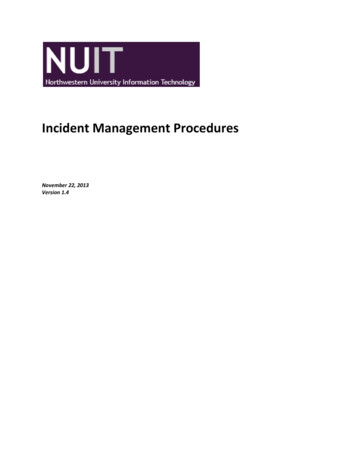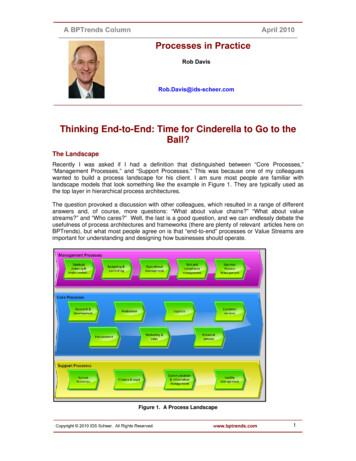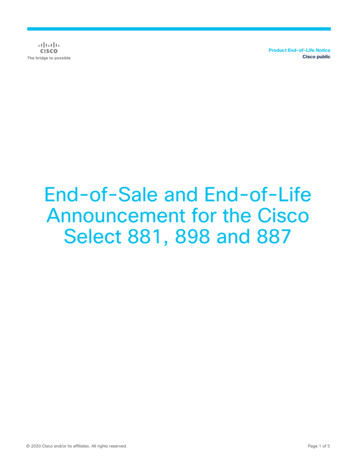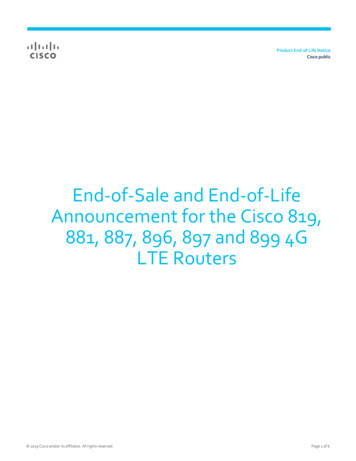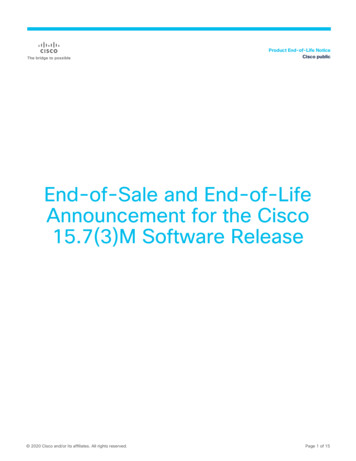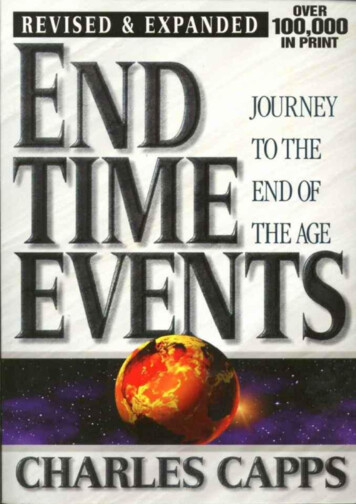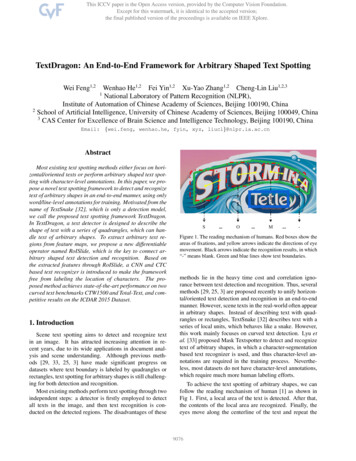
Transcription
TextDragon: An End-to-End Framework for Arbitrary Shaped Text SpottingWei Feng1,2Wenhao He1,2 Fei Yin1,2 Xu-Yao Zhang1,2 Cheng-Lin Liu1,2,31National Laboratory of Pattern Recognition (NLPR),Institute of Automation of Chinese Academy of Sciences, Beijing 100190, China2School of Artificial Intelligence, University of Chinese Academy of Sciences, Beijing 100049, China3CAS Center for Excellence of Brain Science and Intelligence Technology, Beijing 100190, ChinaEmail: {wei.feng, wenhao.he, fyin, xyz, liucl}@nlpr.ia.ac.cnAbstractMost existing text spotting methods either focus on horizontal/oriented texts or perform arbitrary shaped text spotting with character-level annotations. In this paper, we propose a novel text spotting framework to detect and recognizetext of arbitrary shapes in an end-to-end manner, using onlyword/line-level annotations for training. Motivated from thename of TextSnake [32], which is only a detection model,we call the proposed text spotting framework TextDragon.In TextDragon, a text detector is designed to describe theshape of text with a series of quadrangles, which can handle text of arbitrary shapes. To extract arbitrary text regions from feature maps, we propose a new differentiableoperator named RoISlide, which is the key to connect arbitrary shaped text detection and recognition. Based onthe extracted features through RoISlide, a CNN and CTCbased text recognizer is introduced to make the frameworkfree from labeling the location of characters. The proposed method achieves state-of-the-art performance on twocurved text benchmarks CTW1500 and Total-Text, and competitive results on the ICDAR 2015 Dataset.1. IntroductionScene text spotting aims to detect and recognize textin an image. It has attracted increasing attention in recent years, due to its wide applications in document analysis and scene understanding. Although previous methods [29, 33, 25, 3] have made significant progress ondatasets where text boundary is labeled by quadrangles orrectangles, text spotting for arbitrary shapes is still challenging for both detection and recognition.Most existing methods perform text spotting through twoindependent steps: a detector is firstly employed to detectall texts in the image, and then text recognition is conducted on the detected regions. The disadvantages of theseS.O.M.-Figure 1. The reading mechanism of humans. Red boxes show theareas of fixations, and yellow arrows indicate the directions of eyemovement. Black arrows indicate the recognition results, in which“-” means blank. Green and blue lines show text boundaries.methods lie in the heavy time cost and correlation ignorance between text detection and recognition. Thus, severalmethods [29, 25, 3] are proposed recently to unify horizontal/oriented text detection and recognition in an end-to-endmanner. However, scene texts in the real-world often appearin arbitrary shapes. Instead of describing text with quadrangles or rectangles, TextSnake [32] describes text with aseries of local units, which behaves like a snake. However,this work mainly focuses on curved text detection. Lyu etal. [33] proposed Mask Textspotter to detect and recognizetext of arbitrary shapes, in which a character-segmentationbased text recognizer is used, and thus character-level annotations are required in the training process. Nevertheless, most datasets do not have character-level annotations,which require much more human labeling efforts.To achieve the text spotting of arbitrary shapes, we canfollow the reading mechanism of human [1] as shown inFig 1. First, a local area of the text is detected. After that,the contents of the local area are recognized. Finally, theeyes move along the centerline of the text and repeat the9076
GroupText Recognizer.B.Y.S.H .Text Detector.StemNetworkLocal BoxRegressionCenterlineSegmentationT.L.-.L.H coderFigure 2. The overview of the proposed framework. Text of arbitrary shapes can be detected and recognized in a single forward pass.above three steps. There are two advantages of this readingprocess. On one hand, text of arbitrary shapes can be splitinto a series of local units, so detecting local area ratherthan the whole text could be more robust to the diversityof text shapes. On the other hand, characters in one textmay have different sizes and orientations as shown in Fig 1.Therefore, recognizing only one local area at a time, ratherthan the whole, can overcome the variations of charactersize and orientation.Inspired by the above analysis and the name ofTextSnake, we propose a novel scene text spotter namedTextDragon as shown in Fig 2. Specifically, a text detector is used to describe the shape of text with a series of local quadrangles, which is adaptive to describe complex textshapes. To connect the detection and recognition modules, afeature operator named RoISlide is proposed to extract andrectify arbitrary text regions from feature maps, which canreduce the influence of changes in character size and orientation. After that, rectified text features are fed into a Convolutional Neural Network (CNN) and Connectionist Temporal Classification [9] (CTC) based text recognizer to generate the final recognition result, making the framework freefrom character-level annotations. As the framework integrates both text detection (like an improved snake body) andtext recognition (a newly grown paw branch from snake)modules into an end-to-end trainable system, the whole textspotting process is like the shape of a dragon. To the best ofour knowledge, this is the first end-to-end trainable framework for scene text spotting of arbitrary shapes, using onlyword/line-level annotations for training.Our contributions are in three folds: (1) A novel endto-end scene text spotter named TextDragon is proposed,which is flexible for text of arbitrary shapes. (2) A new differentiable operator RoISlide is designed to unify arbitraryshaped text detection and recognition into an end-to-endpipeline. (3) The proposed model can be trained in weaklysupervised manner with only word/line-level annotations,which improves the model’s practicability. TextDragon iseffective for both curved and oriented text spotting, and hasachieved state-of-the-art performance on two curved textbenchmarks Total-Text [6] and CTW1500 [31], and performs competitively on the ICDAR 2015 Dataset [23].2. Related WorkIn literature, text spotting is referred to the joint processof text detection and recognition. Therefore, in this section,we review related works from perspectives of text detection, recognition and spotting, respectively. Surveys can befound in [47, 50].2.1. Scene Text DetectionTraditional methods [43, 13, 4] first localize charactersand then group them into words. Deep learning based methods [27, 15, 49] detect words directly without redundantintermediate steps. Although they make great progress onstandard benchmarks, these methods impose strict restrictions on the shape of text.Recently, several methods are proposed to detect curvedtext in the wild. Liu et al. [31] integrated the recurrent transverse and longitudinal offset connection to detect curvedtext, which is described by a 14 vertexes polygon. Wang etal. [46] proposed an arbitrary shape text detection methodwith adaptive text boundary representation using a recurrentneural network. Long et al. [32] described the curved textas a series of ordered, overlapping disks centered at symmetric axes. However, the shape of disks is not convenientto connect with the text recognizer. The proposed methoddescribes the curved text as quadrangles rather than disks,which are easier for the connection between text detectionand recognition.2.2. Scene Text RecognitionTraditional methods like [44, 21, 34] detect and recognize each character firstly, and then integrate them into9077
words. Deep learning based methods extract features fromthe whole image by CNN [12], and then employ RecurrentNeural Network (RNN) to generate sequential labels [42].However, these methods regard texts as one-dimensional sequences, which are not suitable for curved text recognition.To handle curved text, Shi et al. [39] and Liu et al. [28]introduced the spatial attention mechanism to transform thecurved text into a suitable pose for recognition. Cheng etal. [5] proposed the arbitrary orientation network to dealwith irregular texts, in which the features are combined intoan attention-based decoder.Input Image3. MethodologyOur proposed end-to-end scene text spotting frameworkis shown in Fig 2. First, a stem network is used to extractvisual features on the input image. After feature extraction,the text detector is applied to describe each text with a seriesof quadrangles, which locate along the centerline. Then, thenewly proposed RoISlide extracts features along each textcenterline from feature maps, in which a local transformernetwork converts features in each quadrangle into rectifiedones. Finally, the CNN based text recognizer predicts thecategory of each quadrangle, and decodes the sequenced result using a CTC decoder. The modules of text detectionand recognition are trained jointly on images of texts without character-level annotations. In the following, we willintroduce the details of the detector, RoISlide, recognizerand inference procedure.3.1. Text DetectionTo detect text with arbitrary shapes, we adopt similaridea in TextSnake [32] by predicting local geometry at-Conv Stage 2128, 1/2Upsample128, 2Conv Fuse 3128, 1 1Conv Stage 3256, 1/2Upsample128, 2Conv Fuse 2128, 1 1Conv Stage 4512, 1/2Upsample128, 2Conv Fuse 1128, 1 1Conv Stage 5512, 1/2Centerline SegmentationLocal Height2.3. Scene Text SpottingMost existing methods treat scene text spotting [19, 2,26] as two separate steps: the first step is to detect text linesand the second step is to recognize them. However, themultitude of steps may require exhaustive tuning, leadingto sub-optimal performance and time consumption.Recently, Li et al. [25] proposed an end-to-end text spotter which focuses on horizontal texts. Liu et al. [29] introduced a differentiable operator RoIRotate, which extracts oriented text regions from feature maps. Patel etal. [35] proposed an end-to-end method for multi-languagetext spotting and script identification. However, these methods can only deal with horizontal or oriented texts. On thebasis of Mask-RCNN [11], Lyu et al. [33] detect and recognize text instances of arbitrary shapes by segmenting thetext regions and character regions. Unlike [33], our methoddoes not need character-level annotations. Moreover, theanchor mechanism in [33] may not be able to generate suitable text proposals as the shape of curved text is highly variable.Conv Stage 164, 1/2Local OrientationθFigure 3. The architecture of text detector. “Conv Stages” 1-5 arefrom VGG-16, and “Upsample” represents a deconvolution layerof 128 channels with stride 2. We only show part of the bounding boxes in the Local Height branch for better visualization, butactually the bounding boxes are much more dense.tributes of text shown in Fig 3. However, TextSnake usesdisks to represent local geometric attributes, which is difficult for the subsequent feature extraction, thus text is represented as a series of quadrangles here. To detect texts ofa wide scale range, we merge feature maps from differentlevels and upscale the fused feature map to 1/4 size of theinput image. The output module consists of two tasks: Centerline Segmentation and Local Box Regression. The outputmaps of the two tasks are also 1/4 size of the input image.The rest of this subsection will introduce details of the twotasks.Centerline Segmentation. This task is to extract text regions from images and can be deemed as down-sampledpixel-level classification between text (positive category)and non-text (negative category). Instead of segmenting allpixels within the text region out, here we only regard thecenterline region which is a shrunk version of the originaltext area as positive. The eroded text region is to relieve thetouching effect when texts are close to each other and bringsbetter local units grouping results in the inference stage. Toalleviate the negative influence of class imbalance betweentext and non-text, online hard example mining (OHEM) introduced in [40] is adopted during the training stage.The loss function Lseg for Centerline Segmentation taskis derived from the cross entropy loss. Denote the set ofselected elements by OHEM as S, Lseg is formulated as:9078
.Figure 4. The illustration of RoISlide. The green arrows indicatethe direction of sliding, and the blue arrows indicate the resultsof each quadrangle through RoISlide. We show the process ofRoISlide on the input image for better visualization, but actuallythe operation is on the feature maps.1 XL (ps , p s ) S s S1 X( p s log ps (1 p s ) log (1 ps )) , S s S(1)where · is the number of element in a set, and L (ps , p s )refers to the cross entropy loss between the predicted pixellevel text score ps and the corresponding ground truth p s(p s {0, 1}).Local Box Regression. This task is to depict the local quadrangles of each text to facilitate the further curved boundarygeneration and text recognition. Each local quadrangle isrepresented by two geometry attributes in this task. The firstattribute is the local text height, which is represented by asquared box as shown in Fig 3, where the box side length isequal to the local text height. The second attribute is the local text orientation, which is the tangent angle of the curvedtext as shown in Fig 3.Given a pixel i located in the positive area P in Centerline Segmentation task, the loss function Lreg for LocalBox Regression task is formulated as:Lseg 1 XBi Bi LB ,SmoothL1θi θi Lθ P i P(2)Lreg LB λθ Lθ ,(3)where Bi and θi are predicted local squared box and angle,respectively, while Bi and θi are the corresponding groundtruth. λθ is a hyper-parameter which is set to 10 in ourexperiments. We choose SmoothL1 loss [36] here for itsrobustness to variation in object shape.3.2. RoISlideText shapes in the real-world vary tremendously, therefore, it is difficult to directly transform the whole text fea-tures into axis-aligned features. As the text detection branchhas transformed the shape of text into a series of quadrangles, RoISlide is proposed to transform the whole text features into axis-aligned features indirectly by transformingeach local quadrangle sequentially, which is the key to makethe framework end-to-end trainable. Specifically, the RoISlide has two steps: firstly, we arrange quadrangles which aredistributed along the text centerline in order. Then a LocalTransformer Network (LTN) is proposed to transform feature maps cropped from each quadrangle into rectified onesin a sliding manner. After the above two steps, arbitraryshaped text features are converted into sequenced squaredfeature maps of identical dimension as shown in Fig 4.Denote the sequenced quadrangles after the first step asR {R1 , R2 , ., RN }. For each quadrangle Rn , the LTNconverts features in Rn into a unified spatial dimensionwhich is H H, and we set H to 8 in the experiment.To achieve this goal, the LTN first computes a series ofaffine transformation matrices M {M1 , M2 , ., MN } using features in R, which contain 6-dimensional parameters.The LTN consists of two convolution max pooling layers,followed by two fully-connected layers for the regression ofthe transformation parameters. It should be noticed that theLTN is trained jointly with other modules without the needof position supervision.After that, a grid generator generates a sampling grid toperform a warping of the input features. The point-wiseaffine transformation can be written as: t s 11 xtcxc1213θθn θn t xcyc , (4) Mn yct n21θn θn22 θn23ycs11where (xsc , ycs ) and (xtc , yct ) represent the coordinate of apoint on the shared feature maps and transformed featuremaps respectively.Finally, the RoI features are extracted from the sharedfeature maps with the set of sampling points, in which theinterpolation method is bilinear interpolation.Spatial transformer network (STN) [20] also uses affinetransformation, which is mainly focused on transformingwhole images. Different from STN, the proposed LTN takeslocal feature maps as input, and the transformed local feature maps make up the whole text features, which is moredomain-specific for the arbitrary shaped text spotting.3.3. Text RecognitionAlthough the shapes of texts are arbitrary, humans’ eyesalways read along the centerline. Meanwhile, their eyes donot move continuously, but make short rapid movements.Inspired by [45, 48], we adopt the sliding convolution character models rather than traditional LSTM [16] to recognizetexts of arbitrary shapes for fast recognition. Unlike [45, 48]which extract features from the original images, we predict9079
Input BoxesTable 1. The network architecture of the text recognizer. Eachconvolutional layer is followed by a batch normalization layer anda ReLU layer. W is the number of character classes.TypeInputConv bn reluConv bn reluMax PoolingConv bn reluConv bn reluMax PoolingConv bn reluConv bn reluFully ConnectionFully ConnectionConfigurationsN 8 83 3, 128, stride 1 13 3, 128, stride 1 12 2, stride 2 23 3, 256, stride 1 13 3, 256, stride 1 12 2, stride 2 23 3, 512, stride 1 13 3, 512, stride 1 1256, drop: 0.5WNXP (πn n, X).Recognition -K--E-T-Figure 5. The procedure of inference. Red quadrangles show theinput boxes of the inference stage. After grouping, quadrangleswith the same color represent the same group. Yellow arrows indicate the directions of sorting. In the output boundaries, dots showthe vertexes after sampling. In the classification result, “-” meansblank.text labels with the features transformed by RoISlide. Thetext recognition branch consists of two parts: a characterclassifier and a transcription layer. The character classifierpredicts a label distribution from the input squared features,and the transcription layer decodes each square’s predictions into the final sequence.As the input features are transformed from the sharedfeature maps, which contain rich semantic information, wereplace the network in [48] with a simpler one as shown inTable 1. Each convolutional layer is followed by a batchnormalization [17] (BN) layer for fast convergence. Afterevery two convolutional layers, max-pooling layer is usedto halve the size of feature maps. The final convolutionaloutput is flattened into a vector of length 2048, and thenfed into the following two fully-connected layers. To avoidoverfitting, we insert one dropout layer after the first fullyconnected layer. Finally, we use the softmax layer to geteach square’s label distribution.In the transcription layer, we adopt the CTC decoder [9]and assume that each squared features after RoISlide represents a time step. The CTC decoder aims to transform eachsquare’s probability distribution to the label sequence. Denote the probability distribution at step n as P (k n) and π isa CTC path, whose sequence length is equal to the numberof squares N . The probability P (π X) can be written as:P (π X) Output Boundaries(5)n 1Then, a CTC mapping function B is used to remove repetitions and delete the blank. The conditional probability ofthe ground truth y is the sum of the probabilities of all thepaths by B:XP (y X) P (π X),(6)π B 1 (y)and the objective is to maximize the log likelihood of con-ditional probability of ground truth. Denote the number ofwords in the input image as M . The loss for text recognitionLrec can be written as:Lrec M1 Xlog p(y X).M m 1(7)For end-to-end training of text detection and recognition,the whole loss function can be formulated as:L Lseg λreg Lreg λrec Lrec ,(8)where λreg and λrec are the hyper-parameters to control thebalance among each task.3.4. InferenceIn the inference stage, our goal is to provide the textboundary through detector, as well as the text content together with recognizer. We first apply thresholding to thetext centerline segmentation map, and then NMS is appliedto the local bounding boxes to reduce redundancy. Finally,four steps are conducted based on the quadrangles producedby NMS to get the final results as shown in Fig 5.Group. Given the input boxes, instead of using the disjointset as introduced in TextSnake [32], we group boundingboxes according to their geometric relation. In order tomake the connected component complete, full resolutionand low threshold are used in TextSnake, which will lead tomore noise and heavy time consumption, but we can use ahigher threshold and quarter resolution output to avoid theseproblems. Each box in a group should satisfy two heuristicconditions with at least other one box in the same group:(1) Their IoU should be higher than 0.5; (2) their absoluteangle difference should be less than π/4.Sort. After grouping bounding boxes, we sort the boxes forboundary generation and text recognition. First, we judgewhether the overall direction is horizontal or vertical according to the average angle of all boxes within the same9080
(a)(b)(c)(d)Figure 6. (a, b) showing that end-to-end training helps text detection. (c, d) showing that RoIRotate leads to wrong recognition results forcurved text. In the first row, from left to right: detection without guidance from recognition and TextDragon. In the second row, from leftto right: with RoIRotate and with RoISlide. Green dots show the vertexes of polygons.group. Then boxes are sorted from left to right (horizontal)or from top to bottom (vertical).Sample. For boundary generation, we just evenly samplethe ordered boxes to form the vertexes of polygons. Thenthe boundary of text is generated by linking the vertexessequentially.Recognize. For text recognition, we first perform RoISlideon the shared feature maps with the ordered boxes. Theneach transformed features are classified by the characterclassifier. Finally, the CTC decoder is used to predict thefinal recognition result.col of end-to-end recognition follows that for CTW1500.ICDAR 2015. The ICDAR 2015 dataset contains 1000training images and 500 test images. Each text is labeledas a quadrangle with 4 vertexes in word-level. The textspotting task reports results over three lexicons: “Strong”,“Weak” and “Generic”. Strong lexicon provides 100 wordsthat may appear in each image. Weak lexicon provideswords in the whole test set, and generic lexicon providesa 90K vocabulary.4. ExperimentsOur implementation is based on Caffe framework [22].The stem network VGG-16 [41] inherits parameters trainedon ImageNet dataset [24], and then we pre-train the modelon SynthText [10] for 600k iterations, and fine-tune on otherdatasets for 120k iterations. The input images of 512 512are cropped from images after random scaling and rotation.We first set the loss weight λreg and λrec to 0.01, and thenwe raise them to 0.1 and 0.05 respectively after the segmentation task is well optimized. In the pre-training stage, thelearning rate is 0.01. During the fine-tuning stage, we trainthe model with a learning rate of 0.001. Experiments areimplemented on a workstation with 2.9GHz 12-core CPU,256G RAM, GTX Titan X and Ubuntu 64-bit OS.We evaluate both text spotting and detection performance of the proposed method on several standard benchmarks. Moreover, analysis of each module and comparisonswith previous methods are also given to demonstrate the superiority and reasonableness of TextDragon.4.1. DatasetsCTW1500. The CTW1500 dataset contains 1000 trainingimages and 500 test images. Each image has at least onecurved text. Horizontal and multi-oriented texts are alsocontained in this dataset. Each text is labeled as a polygon with 14 vertexes in line-level. The evaluation protocol of end-to-end recognition is similar to ICDAR 2015,where quadrangles are changed to arbitrary polygons. Wereport the end-to-end recognition results over two lexicons:“None” and “Full”. “None” means that no lexicons are provided, and “Full” lexicon provides all words in the test set.Total-Text. The Total-Text dataset has 1255 training images and 300 test images, which contains curved text, aswell as horizontal and multi-oriented text. Each text is labeled as a polygon in word-level, and the evaluation proto-4.2. Implementation Details4.3. Ablation StudiesFor better understanding the strengths of the proposedmethod, we first provide the ablation studies from threeaspects. First, we demonstrate the benefits of end-to-endtraining. Second, we compare RoISlide and RoIRotate onrecognition performance under different text shapes. Third,we compare the proposed CNN based recognizer with themore popularized LSTM based one.9081
Table 2. Results on CTW1500 test set.MethodSegLink [37]EAST [49]DMPNet [30]FOTS [29]CTD [31]CTD TLOC [31]TextSnake [32]Our Two-StageWith RoIRotateWith 784.384.5DetectionRF40.0 40.849.1 60.456.0 62.252.0 62.865.2 69.569.8 73.485.3 75.681.0 80.283.4 82.381.8 83.082.8 83.6Table 3. Results on Total-Text test set.End-to-EndNone SegLink [37]Ch’ng et al. [6]EAST [49]FOTS [29]Liao et al. [27]Mask TextSpotter [33]TextSnake [32]Our Two-StageWith RoIRotateWith 085.285.6DetectionRF23.8 26.733.0 36.036.2 42.038.0 44.045.5 52.555.0 61.374.5 78.474.2 79.074.3 79.775.7 80.275.7 80.3End-to-EndNone .748.874.8Table 4. Results on ICDAR 2015 test set. “P”, “R”, “F” represent “Precision”, “Recall”, “F-measure” respectively. “S”, “W”, “G” representrecognition with “Strong”, “Weak”, “Generic” lexicon respectively. “*” indicates that the method is designed for text of arbitrary shapes.MethodSegLink [37]EAST [49]He et al. [15]TextSnake [32]PixelLink [7]Mask TextSpotter [33]He et al. [14]FOTS [29]Our DetectionWith 82.683.786.087.089.8483.0587.3187.88MethodBaseline OpenCV3.0 [23]Stradvision [23]TextProposals [8, 18]HUST MCLAB [37, 38]Deep text spotter [3]Mask TextSpotter [33]He et al. [14]FOTS [29]Our Two-StageWith RoIRotateTextDragonSpotting with vs. without End-to-End TrainingThe recognition supervision can provide more detailed textstroke features for text detection. Without end-to-end training, text detection may miss some text regions or misclassify text-alike background. To demonstrate the importance of end-to-end training, we evaluate a variant of ourmethod in which text detection and recognition are trainedseparately. As shown in Tables 2, 3 and 4, the end-to-endtraining based methods (including TextDragon and otherconfigurations) outperform our two-stage method significantly in text detection and end-to-end recognition. Furthermore, using different text recognizers in end-to-end trainingshows similar performances in text detection. It demonstrates that the text recognition supervision can provide textstroke features for text detection no matter which kinds oftext recognizers are used.Some qualitative results are shown in Fig 6. In theFig 6(a), with end-to-end training, text whose feature isnot salient could also be detected. In the Fig 6(b), theflag which has repetitive structured stripes is well classifiedwhen adopting the recognition 062.477.063.079.11 65.3373.15 53.0479.21 65.3778.34 65.15Word SpottingSWG14.65 4.285.080.065.087.01 82.39 67.9777.03 75.11 54.5186.20 82.03 68.1486.22 81.62 68.03RoISlide vs. RoIRotateThe RoIRotate operator [29] aims to transform features withaffine transformation in a similar way, in which the transformation parameters are calculated from the detection results.However, the RoISlide operator gets transformation parameters by the proposed LTN. Through analyzing the recognition results, we argue that RoIRotate may be unsuitable forcurved text, because the characters at the junction of twoquadrangles will rotate with two different θ, causing difficulties in recognizing characters. Two examples are shownin Fig 6. The character “A” in the Fig 6(c) and the character “E” in the Fig 6(d) are mis-classified with RoIRotate, asthey are located at the junction of two quadrangles.Therefore, we use the transformation parameters predicted by the LTN rather than detection results. To further explore the impact of RoIRotate on text of differentshapes, we evaluate a variant of our method with RoIRotatefor curved and oriented text. Tables 2 and 3 show that usingRoIRotate for curved text will reduce the end-to-end recognition performance, indicating that getting transformationparameters from detection results is not suitable for curved9082
Figure 7. Examples of word spotting results. First column: CTW1500; second column: Total-Text; third column: ICDAR 2015.text recognition. Although the orientation of each character in oriented text is consistent, Table 4 shows that RoISlide and RoIRotate achieve similar performance on orientedtext, which verifies the generalization ability of RoISlide.4.3.3Spotting with vs. without LSTMMost previous text recognition methods are based onLSTM, which predict classification results sequentially. Butour text recognition model can classify each local box inparallel instead of sequential prediction like LSTM, andtherefore our method is faster than those based on LSTM.To verify the effectiveness of CNN based recognizer, weevaluate a variant of our method which adds a bi-directionalLSTM before the fully-connected layer in t
spotting process is like the shape of a dragon. To the best of our knowledge, this is the first end-to-end trainable frame-work for scene text spotting of arbitrary shapes, using only word/line-level annotations for training. Our contributions are in three folds: (1) A novel end-to-end scene text spotter named TextDragon is proposed,
